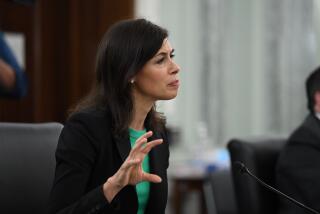Clinton Orders Freeing of Spectrum for Wireless
WASHINGTON — President Clinton on Friday unveiled an ambitious schedule to free up the frequencies needed for advanced wireless phones that offer high-speed Internet access.
In an executive order, Clinton told the Pentagon, Commerce Department, Federal Communications Commission and other agencies to work more cooperatively so the government could sell the frequencies to private companies and enable entrepreneurs to offer consumers advanced wireless phones by 2003.
Clinton’s executive order is the latest evidence of increasing concern by administration officials that the United States is falling behind in the race to offer the most-talked-about new technology of coming years.
The wireless phone industry hopes to capitalize on the growing appetite for mobile applications offered by the Palm and other hand-held devices. The administration is studying whether to let the industry use frequencies reserved for the military or others set aside for commercial microwave users.
“If the United States does not move quickly to allocate this spectrum, there is a danger that the U.S. could lose market share in the industries of the 21st century,” Clinton said in a statement.
Much of the schedule announced by Clinton has been in place since the summer, when the National Telecommunications and Information Agency, an arm of the Commerce Department, asked the Pentagon to determine by Nov. 15 the cost and complexity of allowing private industry to use frequencies in the 1755-to-1850-megahertz band. Those airwaves are reserved for Air Force communications, intelligence gathering and the global positioning satellite navigational system.
The military’s frequencies are coveted by telephone carriers because they are adjacent to those used by domestic wireless phone services and include frequencies that the World Radio Conference earmarked in May for next-generation wireless phones.
But the Pentagon has resisted the telecommunications agency overtures--saying that freeing up the frequencies could take as long as 30 years and cost hundreds of millions of dollars.
Clinton’s executive order, however, was applauded by AT&T; Corp., the nation’s largest wireless carrier. Other observers attached less significance to the president’s action.
Clinton simply “stated what I understood to be our policy all along,” said Scott Blake Harris, a Washington communications lawyer and former chief of the FCC’s International Bureau. “I think it would be reasonable to infer that he acted . . . [mostly to quell] traditional turf battles” between agencies.
Herschel Shosteck, head of a Wheaton, Md., communications consulting firm, agreed with that assessment and added that even if agencies meet the president’s ambitious timetable, the U.S. will remain two to three years behind the Japanese and one to two years behind the Europeans in advanced wireless technology.
“The executive order is not going to change the challenges of finding appropriate frequencies or removing the incumbents and developing equipment” for advanced wireless service, Shosteck said.
Clinton’s executive order was accompanied by a report from the White House Council of Economic Advisors. The council said that next-generation wireless phones will greatly benefit wireless service providers and equipment makers such as Motorola Inc. The fast-growing wireless industry already boasts more than 100 million subscribers, employs 150,000 workers and has $44 billion in annual revenue.






